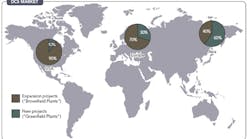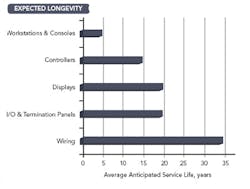"Migration could be the biggest single issue facing automation end-users today," stresses a report from the ARC Advisory Group [1]. ARC estimates that installed automation systems worth about $65 billion are reaching the end of their useful lives. Distributed control systems (DCSs) more than 20 years old will need replacement within the next ten years.
The major driver for migration is the lack of availability of many of the microprocessors used in the original cards; providing the same functionality now requires redesigned cards and often a different hardware base. Many plants will replace their systems with updated ones from the same supplier or retrofits from another manufacturer. For DCS vendors, such work at brownfield sites should account for a vast majority of their business in North America and Europe (Figure 1).
Many stakeholders consider automation a commodity and an unavoidable cost. But, in fact, automation has provided some of the most significant performance improvements at some of the lowest incremental costs. So, chemical makers needing to replace obsolete, unreliable or poorly performing control systems should look beyond just a functional replacement and assess taking fuller advantage of today's technology to achieve increased capabilities and flexibility.
MOTIVATION
Factors that spur migration projects often include the impact of downtime of existing control platforms, the cost of maintaining obsolete equipment, and the need to acquire or supervise global business data. Compounding the maintenance headache, consolidation among vendors has led to the abandoning of some legacy systems, making their obsolescence cycle even shorter.
The value proposition of the new system includes the economic impact of a combination of not only hardware and software system technologies but also value-added services, such as retention of institutional knowledge, offered by the system supplier in the migration itself. Another key element is minimizing or even eliminating the downtime required to complete the modernization project.
New control systems can unify process variables, business requirements and asset management into an integrated environment that allows chemical makers to transform process control beyond the capabilities of legacy DCS functionality. With the aging of the workforce, today's automation platforms must focus on plant personnel, making the most of their knowledge and codifying it in the control strategies and simulation tools that form part of these systems.
Obsolescence, of course, doesn't happen on a specific date but rather is a gradual process that starts when a vendor discontinues support. Spare parts then become harder to procure and more expensive. At some point, spares become too expensive or too hard to find, obsolescence becomes inevitable and migration must occur.
In general, because the definition of obsolescence is vague, the economics for a system modernization require not upgrading until obsolescence threatens, and not installing soon-to-be-obsolete hardware on new processes. This means that as you add process units and associated input/output (I/O) to your facility it's likely you'll have different generations of control system hardware across your site — further complicating the upgrade decision because some equipment will be end-of-life/obsolete, some "soon-to-be obsolete" and some relatively new. The supplier of your newest I/O probably can provide the tightest integration for it; this can be a significant factor in your migration decision process.
WARNING SIGNS
The "trick" becomes figuring out when to become concerned that your control system will require replacement. So, ask yourself some crucial questions:
• Is it increasingly hard to secure spare parts and are the ones available too costly?
• Does the inflexibility of your platform make integration with manufacturing execution systems, enterprise resource planning, etc., either impossible or extremely expensive?
• Is knowledge available about your legacy system (not just internally but from your DCS vendor) decreasing year-on-year?
• Do you worry the existing engineering functionality of the legacy system, optimized over many years, will be lost?
If you answered "yes" to several of these questions and don't already have an automation plan or roadmap, it's past time to create one. This plan must specify your corporate policy on automation and should form part of the annual corporate planning process. An automation roadmap generally follows one of two paths: continuous/incremental change, where pieces of the control system are upgraded on a regular basis as the technology evolves; or replacement of the entire system at fixed periods or based on a predetermined set of criteria perhaps similar to the ones listed above. Every organization must choose the path that works best for it.
FRONT-END-LOADING STUDY
Once you've decided it's time to replace your control system, the first step is to complete a front-end-loading study to determine the complete project scope, timing and implementation strategy. The study should identify any potential difficulties with a migration project and provide plans to mitigate them.
This study must consider the lifecycle of a system based on different tiers of longevity (Figure 2). Wiring, for example, typically is good for 30 years or more. I/O and termination panels can last up to 20 years, even though their core chip sets may no longer be available. Controllers usually have a lifecycle of around 15 years, while workstations and consoles generally need replacement after around five years.
Some other major factors to consider include:
• Minimizing downtime during the transition. You must make sure the plant still is safe while shut down and choose a migration strategy. Typical migration options include:
Phased migration. Modernization occurs in gradual steps, replacing the human/machine interface (HMI) or a particular unit first. Installing the full new DCS may take several years.
Complete replacement. The entire system is ripped out all at once during a planned outage. In some cases, hot cutover can minimize downtime and ensure seamless integration of current control assets [2].
System upgrade. The site retains the legacy platform but modernizes elements of it. This may make sense if the DCS supplier continues to offer parts and support.
• Migrating applications, including basic regulatory control. You'll want to take advantage of best practices on how to operate the facility that are incorporated into your legacy system's control algorithms. Bear in mind, however, that the capabilities of the existing platform may limit "best practices" and the new environment likely can enable improving many of these. In addition, in some cases it will make more sense to rewrite the control algorithms rather than to migrate the legacy applications with all their patches and revisions. What's important is replicating the functionality of the algorithms.
• Updating the HMI and operator screen. You must decide whether it's more important to implement the latest advances in alarm management and operator interface or to maintain the look and feel of the existing system.
• Complying with new codes and standards. Many regulations don't apply to systems in place before they went into effect [3]. Migration may mean that a part of your process in compliance because of such "grandfathering" now requires installation of new equipment including, for example, a safety instrumented system with a safety-integrity-level (SIL) rating on your burner management applications.
Phased migration does have its drawbacks in terms of cost and time but is a lower risk approach with less downtime. You may reduce risk and downtime further by simulating the new system prior to installation and using the model to train your staff, especially panel operators, on how to use and interact with the new system.
AVOID MISSTEPS
Four factors frequently lead to migration project failure:
1. Lack of detailed upfront planning to identify all interactions among control system components, their impact on the process, and the skill sets of the individuals involved. As with any control project, the devil always is in the details.
2. Not considering ancillaries. In addition to the control system itself, the automation master plan must cover ancillaries including space allocation, HVAC, uninterruptible power supplies, grounding and power distribution systems to ensure removing the weakest link.
3. Third-party device communication and interface difficulties, especially for legacy protocols and any necessary buffering or gateways that may be necessary between the existing field equipment and the new controllers. Third-party communications also frequently require accurate mapping of a wide range of parameters — a task that's often labor intensive and prone to error.
4. Extended cutover delays and downtime. Control system migration, like most projects, is susceptible to "scope creep" — this may involve, e.g., calibrating field devices, tuning loops, and minor repairs to device ancillaries such as air supplies, tubing, impulse lines, mounting brackets, etc. This extra work can take a toll on the schedule.
EVAULATION
One of the first tasks once the migration project gets the go-ahead is to build — and gain agreement on — a list of selection criteria for the new system. Develop evaluation criteria at the same time. Having evaluation criteria in place before sending out the request for quotation will minimize bias in the weightings for the decision analysis process and ensure the weightings reflect deliberations during list development.
As already noted, communication and interfaces with third-party devices can pose a major stumbling block to automation system upgrades. One way to get a generic or universal I/O gateway is to choose one of the many fieldbus interfaces as an output. The selection process then comes down to picking a bus that's natively supported by the control system.
A new installation likely will require an interface with the safety system. Many DCS suppliers now have integrated safety functionality into the control system via separate specialized I/O cards. The majority of safety systems continue to be stand-alone, though, and thus need a third-party interface with all that implies. However, because DCS companies have been integrating stand-alone safety logic solvers for years, most interfaces between these systems are well defined.
Control system migration will be part of our future. So, we must face its challenges of retaining institutional knowledge, timing the change for maximum return with minimum production impact, and integrating the many different signal types into a coherent whole. Fortunately, as with any project, good planning is key to success, which is something, of course, all good engineers already know.
IAN VERHAPPEN is director and principal consultant of Industrial Automation Networks Inc., Wainwright, AB. E-mail him at [email protected].
References
1. Woll, D., "Optimizing the Control System Migration Value Proposition," ARC Insights, ARC Advisory Group, Dedham, Mass. (Dec. 2010).
2. Schnipke, E., "Hot Cutover Boosts Control System Migration," p. 39, Chemical Processing (May 2008).
3. Summers, A., "Can You Safely Grandfather Your SIS?," p. 42, Chemical Processing (Aug. 2005).




